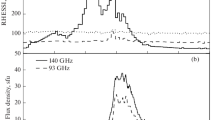Abstract
We consider the plasma mechanism of sub-terahertz emission from solar flares and determine the conditions for its realization in the solar atmosphere. The source is assumed to be localized at the chromospheric footpoints of coronal magnetic loops, where the electron density should reach n ≈ 1015 cm−3. This requires chromospheric heating at heights h ⩾ 500 km to coronal temperatures, which provides a high degree of ionization needed for Langmuir frequencies ν p ≈ 200–400 GHz and reduces the bremsstrahlung absorption of the sub-THz emission as it escapes from the source. The plasma wave excitation threshold for electron-ion collisions imposes a constraint on the lower density limit for energetic electrons in the source, n 1 > 4 × 109 cm−3. The generation of emission at the plasma frequency harmonic ν ≈ 2ν p rather than the fundamental tone turns out to be preferred. We show that the electron acceleration and plasma heating in the sub-THz emission source can be realized when the ballooning mode of the flute instability develops at the chromospheric footpoints of a flare loop. The flute instability leads to the penetration of external chromospheric plasma into the loop and causes the generation of an inductive electric field that efficiently accelerates the electrons and heats the chromosphere in situ. We show that the ultraviolet radiation from the heated chromosphere emerging in this case does not exceed the level observed during flares.
Similar content being viewed by others
References
M. J. Aschwanden, J. C. Brown, and E. P. Kontar, Solar Phys. 210, 383 (2002).
A. Brutsek and Sh. Duran, in Solar and Solar-Terrestrial Physics (Mir, Moscow, 1980) [in Russian].
G. D. Fleishman and E. P. Kontar, Astrophys. J. 709, L127 (2010).
G. D. Fleishman, G. M. Nita, and D. Gary, Astrophys. J. Lett. 620, 506 (2005).
D. A. Guidice and J. P. Castelli, Solar Phys. 44, 155 (1975).
Haisheng Ji, Wenda Cao, and P.R. Goode, Astrophys. J. Lett. 750, L25 (2012).
P. Kaufmann, Astrophys. Space Sci. Proc. 30, 61 (2012)
P. Kaufmann, C. G. G. de Castro, E. Correa, et al., Astrophys. J. 697, 420 (2009).
P. Kaufmann, E. Correa, J. E. R. Costa, and A.M. Zodi Vaz, Astron. Astrophys. 157, 11 (1986).
P. Kaufmann and J.-P. Raulin, Phys. Plasmas 13, 070701 (2006).
P. Kaufmann, J.-P. Raulin, C. G. G. de Castro, et al., Astrophys. J. Lett. 603, L121 (2004).
T. Lüthi, A. Lüdi, and A. Magun, Astron. Astrophys. 420, 361 (2004).
V. F. Melnikov, J. E. R. Costa, and P. J. A. Simoes, in Proceedings of the Pulkovo Conference on Solar and Solar-Terrestrial Physics-2011 (Glavn. Astron. Observ. RAN, St. Petersburg (2011)), p. 159; Solar Phys. (2013, in press).
D. Menzel, Astrophys. J. 85, 332 (1937).
G. M. Nita, D. Gary, and J. Lee, Astrophys. J. 605, 528 (2004).
J.-P. Raulin, P. Kaufmann, C. G. G. de Castro, et al., Astrophys. J. 592, 580 (2003).
J. I. Sakai, Y. Nagasugi, S. Saito, and P. Kaufmann, Astron. Astrophys. 457, 313 (2006).
I. S. Shklovskii, Physics of the Solar Corona (Fizmatgiz, Moscow, 1962; Pergamon Press, London, 1964).
A. V. R. Silva, G. H. Share, R. J. Murphy, et al., Solar Phys. 245, 311 (2007).
B. V. Somov and S. I. Syrovatskii, Sov. Phys. Usp. 19, 813 (1976).
A. V. Stepanov, B. Kliem, A. Krüger, et al., Astrophys. J. 524, 961 (1999).
G. Trottet, S. Krucker, T. Lüthi, and A. Magun, Astrophys. J. 678, 509 (2008).
G. Trottet, J.-P. Raulin, C. G. G. de Castro, et al., Solar Phys. 273, 339 (2011).
J. E. Vernazza, E. H. Avrett, and R. Loeser, Astrophys. J. Suppl. 45, 635 (1981).
V. V. Zaitsev and A. V. Stepanov, Solar Phys. 88, 297 (1983).
V. V. Zaitsev, S. Urpo, and A. V. Stepanov, Astron. Astrophys. 357, 1105 (2000).
V. V. Zheleznyakov, Radiation in Astrophysical Plasma (Yanus-K, Moscow, 1997) [in Russian].
Author information
Authors and Affiliations
Corresponding author
Additional information
Original Russian Text © V.V. Zaitsev, A.V. Stepanov, V.F. Melnikov, 2013, published in Pis’ma v Astronomicheskiı Zhurnal, 2013, Vol. 39, No. 9, pp. 726–736.
Rights and permissions
About this article
Cite this article
Zaitsev, V.V., Stepanov, A.V. & Melnikov, V.F. Sub-terahertz emission from solar flares: The plasma mechanism of chromospheric emission. Astron. Lett. 39, 650–659 (2013). https://doi.org/10.1134/S1063773713090089
Received:
Published:
Issue Date:
DOI: https://doi.org/10.1134/S1063773713090089




